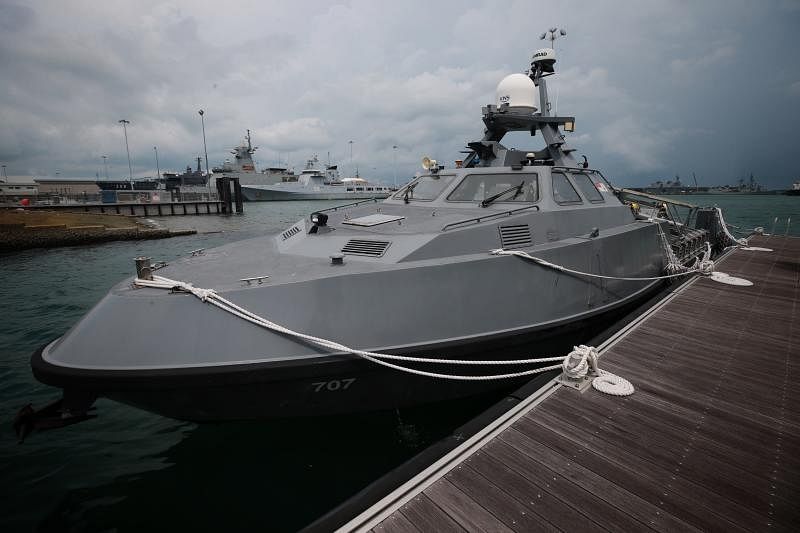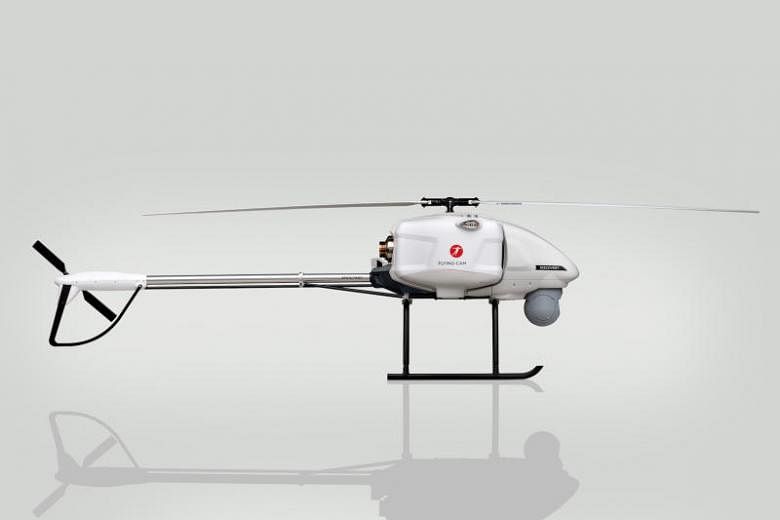SINGAPORE - Since its founding in 1988, unmanned helicopter manufacturer Flying-Cam has been involved in the shooting of about 500 feature films - including the Harry Potter and James Bond series - in more than 75 countries.
In 1995, the Belgian company won an Oscar for technical achievement, for pioneering the development of mounting a motion-picture camera on a remotely-operated miniature helicopter.
The demands of the movie industry, however, have propelled the company in recent years to venture into the defence sector, with its single-rotor helicopters now used for surveillance and reconnaissance, as well as detecting sea mines.
Founder and chief executive Emmanuel Previnaire, 63, said: "The movie industry, while niche, is very demanding, asking for high-quality imagery in all kinds of environments.
"This led us to acquire a lot of know-how, like being able to deploy our helicopters out of a speedboat," he added.
Two such models were unveiled during the company's debut at the 12th International Maritime Defence Exhibition and Conference (Imdex) Asia, a biennial show that opened at Changi Exhibition Centre on Tuesday (May 14) .
The smaller helicopter is about 2.16m long and can cruise at 20 metres per second while the other is about 3m long with a cruise speed of about 25 metres per second.
They can be configured to carry different payloads and sensors, like high resolution cameras, useful for surveillance to determine if the crew of a ship are armed, for instance.
On Monday (May 13), Singapore's navy gave the media a tour of its unmanned surface vessels (USV) that can detect and deactivate sea mines.
A USV, with two operators controlling it remotely, takes about six minutes to deploy sonar equipment to detect the mine.

Currently, the Bedok-class Mine Countermeasure Vessel (MCMV), operated by a crew of about 30 men, takes around 45 minutes to do it.
Senior Lieutenant-Colonel Wong Chng Tong, 45, commanding officer of 194 Squadron, said that the unmanned vessels, when ready, will progressively replace the manned platforms.
"This will help to address the key concern of a declining birth rate. We need to make sure that all our servicemen are effectively deployed," he told reporters on Monday (May 13).
Operational testing of the vessel, called the Mine Countermeasure USV with Towed Synthetic Aperture Sonar, began in June last year(2018) and is expected to be completed in July (2019).
SLTC Wong added that another variant of USV for coastal patrols will be introduced next year (2020). It will do the job now done by patrol and littoral mission vessels, freeing up such manned platforms to carry out more complex missions.
Mr Raymond Tan, 35, a senior program manager (naval systems) with the Defence Science and Technology Agency, said the launch and recovery system had to be designed to fit in the smaller USVs.
"When integrating the sonar and mine disposal systems to a USV with a much smaller footprint, we had to scrutinise the design of the launch and recovery system, to ensure its form, fit and size can work there," he added.
French company Thales, who was among 236 exhibitors from 30 countries at Imdex Asia, has also designed an anti-mine system with USVs and autonomous underwater vessels for the United Kingdom and French navies, making use of remotely-operated vehicles to neutralise mine threats.
Meanwhile, researchers from the Singapore University of Technology and Design's Robotics and Automation Research Lab have developed a robot that could help inspect man-sized drains.
This will improve the efficiency of drain inspectors, who would not need to walk the entire length of the drains to look for cracks, debris and clogs. It is also safer because they need not run the risk of being caught in a flash flood.
Dr Karthikeyan Elangovan, 33, the robot's designer who was at the show, expressed the hope that it will not only be used by inspectors in Singapore but also worldwide.


